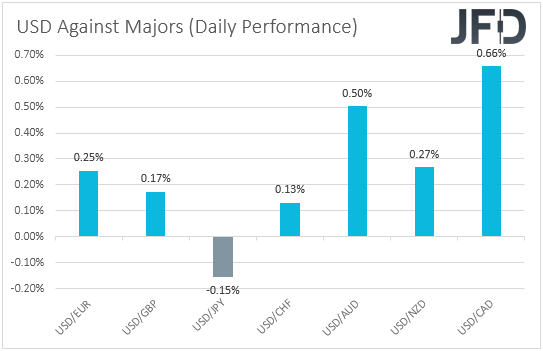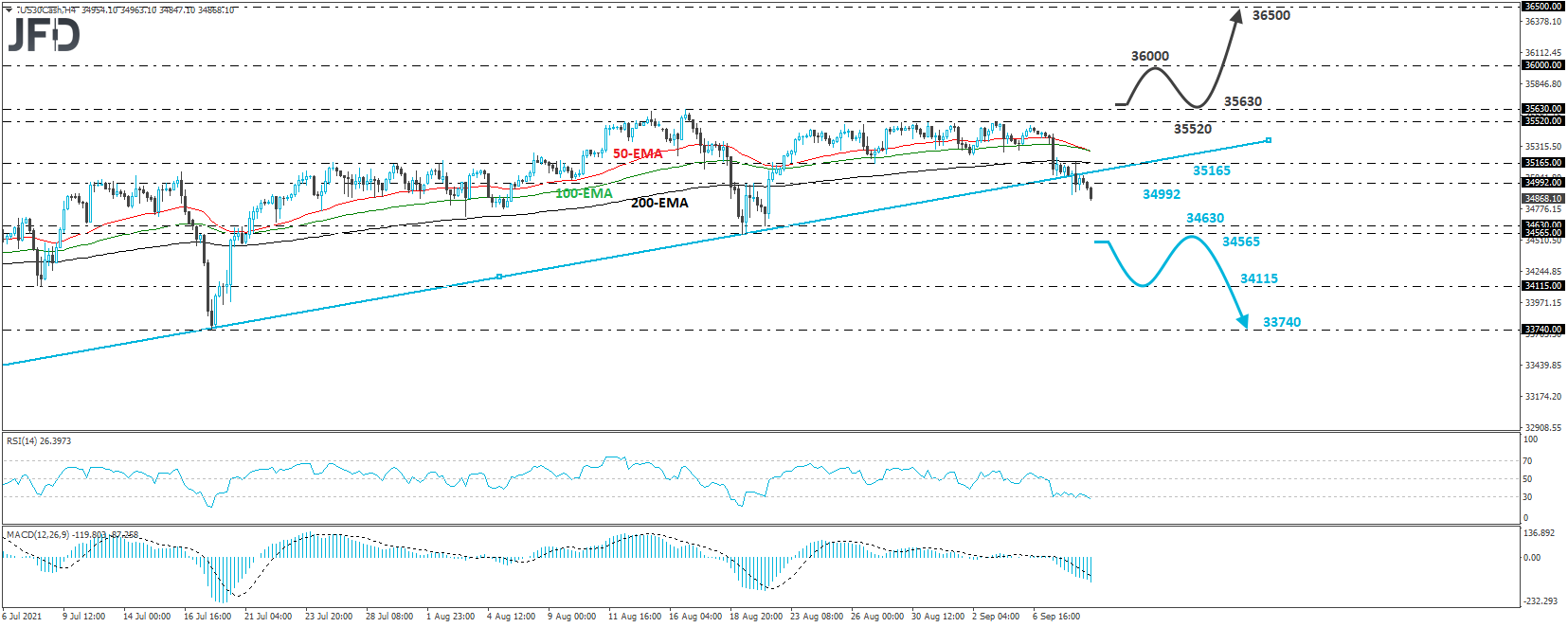Equities around the globe continued sliding yesterday and today in Asia, perhaps due to remarks by some Fed officials that they still expect to start scaling back their asset purchases later this year. We also had a BoC decision, with the Bank standing pat and keeping the door for further tapering at the next gathering open. Today, it is the turn of the ECB to decide on monetary policy, and it will be interesting to see whether policymakers of this Bank will announce a slowdown to their PEPP purchases.
Fed Member Still See Tapering By The End Of The Year
The US dollar traded higher against all but one of the other major currencies on Wednesday and during the Asian session Thursday. It gained the most versus CAD, AUD, and NZD, in that order, while it lost some ground only versus JPY.
The strengthening of the US dollar and the safe-haven yen, combined with the weakening of the risk-linked currencies Loonie, Aussie, and Kiwi, suggests that financial markets traded in a risk-off fashion yesterday and today in Asia. Indeed, looking at the performance in the equity world, we see that major EU and US indices were a sea of red, with the negative appetite rolling into the Asian session today. The only exception was China’s Shanghai Composite, which gained 0.45%.
EU shares may have stayed under selling pressure on growing expectations that the ECB may indeed announce a slowdown in its PEPP (Pandemic Emergency Purchase Program) purchases today. Later in the day, sentiment took another hit after several Fed officials signaled that they still expect to begin trimming their QE purchases before the end of this year, despite the slowdown in jobs growth seen in August. Specifically, St. Louis Fed President James Bullard said that, "The big picture is that the taper will get going this year and will end sometime by the first half of next year," while Dallas Fed President Robert Kaplan said that he still supports the process to start in October. New York President John Williams held a similar view, saying that “Assuming the economy continues to improve as I anticipate, it could be appropriate to start reducing the pace of asset purchases this year.”
Recently, stocks were in an upside trajectory on falling expectations that the Fed will taper this year, and this was due to the latest disappointing US jobs data. However, yesterday’s remarks sparked new hopes on that front and, bearing also in mind that investors were already cautious ahead of the ECB, this resulted in further pullback in equities and further recovery in the greenback. Kaplan’s remarks may have revived some speculation that an official announcement may come as early as at this month’s gathering, but we see as a more likely case the official announcement to come in November, as most policymakers may prefer to wait for the upcoming employment report to see whether the latest miss was a one-off incident, or not.
DJIA Technical Outlook
The Dow Jones Industrial Average cash index continued trading lower yesterday, falling below the upside support line drawn from the low of June 21. In our view, this may have dismissed the bullish case for a while, but in order to start examining a short-term reversal, we would like to see a dip below 34565.
This will confirm a forthcoming lower low on the daily chart and may allow declines towards the 34115 level, marked by the low of July 8, where another break could wake up more bears and perhaps encourage them to push the battle towards the low of July 19, at 33740.
Now, in order to start examining whether the outlook has turned bullish again, we would like to see a break above record peak of 35630, hit on Aug. 16, a move that could set the stage for advances towards the psychological round figure of 36000. If market participants do not stop there, then, we will consider as the next resistance another psychological number, the 36500 mark.
Bank Of Canada Keeps The Door For October Tapering Open
Yesterday, we also had a BoC monetary policy decision. As was widely expected, this Bank kept interest rates at a record low of +0.25% and maintained its current QE program. In the statement, it was noted that they expect growth to strengthen in the second half, though a fourth coronavirus wave and supply bottlenecks could weigh on the recovery. What’s more, they maintained the guidance that the economic slack would be absorbed sometime in H2, 2022, which means this is when they expect to start raising interest rates.
Following the latest disappointing data, especially the economic contraction in Q2, many participants may have been expecting the Bank to announce a delay in its tapering plans. However, that was not the case. Yes, there was no action at this gathering, but this could be due to the fact that the federal elections are planned in less than two weeks, and perhaps because this was a smaller meeting, with no updated economic projections and a press conference. In our view, the door for a further tapering in October remains open, but we prefer to pay attention to upcoming data releases before we arrive to more safe conclusions on that front. Further weakness could diminish the chances for such an action, and perhaps keep the Loonie under selling interest.
Will The ECB Taper Its PEPP Purchases Today?
Today, as we already noted, it is the turn of the ECB to decide on monetary policy. At its latest gathering, the ECB kept all of its settings untouched, but changed its forward guidance, saying that it will keep interest rates at present or lower levels until it sees inflation reaching 2% well ahead of the end of its projection horizon, which may also imply a period during which inflation moderately overshoots that objective. In our view, this translates into willingness to hold rates low for much longer than the previous guidance suggested.
With the Bank unlikely to make any guidance changes at this meeting, all the attention is likely to fall on its QE programs. With the economic recovery gathering pace in the bloc, inflation in August accelerated to a rate not seen in the past decade, with the underlying metric getting closer to the Bank’s new 2% target. ECB President Lagarde and some of her colleagues consider the jump to be driven by one-off, pandemic-related effects, and thus, they don’t want to rush into policy changes. However, others, including Vice President Luis de Guindos and Governing Council member Jens Weidmann, believe that they should consider gradually scaling back their programs, with the volume of the hawkish voices increasing lately.
With that in mind, according to media reports, many market participants believe that officials will reduce the pace of their PEPP program to EUR 60bn per month from the current EUR 80bn, before another fall early next year and a scheduled end in March. However, even if they scale down PEPP due to approaching its expiry, we believe that they could compensate by making more purchases through other schemes.
As for the euro, it could gain on a tapering decision, but whether the rally will be strong and long lasting will depend on any accompanying decision on other schemes, and any remarks on future plans. Now, in case officials decide to wait for a while longer before proceeding with a tapering step, the euro is likely to depreciate. In our view, this is not an unreasonable scenario. Some officials may prefer to wait and see what happens with the pandemic and its new mutations after the summer.
EUR/CAD Technical Outlook
EUR/CAD has been in a rally mode this week, after hitting support at the 1.4857 level and the upside support line drawn from the low of Aug. 12. Yesterday, the rate hit resistance at 1.5062, corrected lower, but found support at 1.4960 and rebounded again. Overall, the pair continues to trade above the aforementioned upside support line and thus, we will consider the short-term outlook to be positive.
At the time of writing, the rate is heading for another test at 1.5062, where a break could pave the way towards the peak of Aug. 20, at 1.5115. If the bulls are not willing to stop there either, then we could see them climbing towards the 1.5190 zone, defined as a resistance by the high of Apr. 21.
In order to start examining a bearish reversal, we would like to see a dip below 1.4857. Such a move could confirm the break of the pre-mentioned upside line and may open the path for declines towards the low of Aug. 25, at 1.4793. IF that level is also breached, then we could see the fall extending towards the inside swing high of Aug. 12, at 1.4706.
As For The Rest Of Today's Events
The only other events worth mentioning, besides the ECB decision, are the US initial jobless claims for last week, which are forecast to have slid to 335k from 340k, and the Energy Information Administration report on crude oil inventories for last week, which is expected to reveal a 4.612mn barrels slide, following a 7.169mn tumble the week before. That said, bearing in mind that the American Petroleum Institute revealed a 2.882mn barrels slide, we would consider the risks of the EIA number as tilted to the upside.
As for the speakers, besides ECB President Christine Lagarde, who will speak at the press conference following her Bank’s decision, we will also get to hear from New York Fed President John Williams, San Francisco Fed President Mary Daly, Fed Board Governor Michelle Bowman, and BoC Governor Tiff Macklem. Daly and Bowman may provide their own view on the Fed’s future course of action, while Macklem could provide clearer hints as to whether his Bank is planning to proceed with another tapering step in October.
